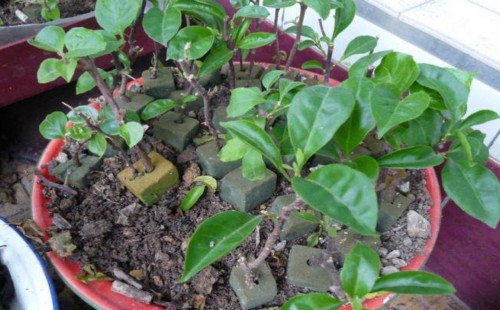How to water the bonsai of black bone tea on the pot?
Black bone tea pot transfer includes seedling transplant pot or old pile pot and pot change when the pot. However, whether it is a new pot or a new pot for black bone tea, we must follow scientific and standardized operations. In order to make the black bone tea bonsai tree in the pot can smoothly realize the slow seedling kimono pot, in addition to the operation to standardize, the method is also very important. One of the key links is whether to water after the pot, how to water the problem.

Under normal circumstances, no matter whether it is a new pot or a new pot, watering after the pot is very critical, which will directly affect the survival rate and survival effect of black bone tea. After finishing the pot, we should first water it in time, and as root water, we usually irrigate it thoroughly. And for most of the new potted bonsai trees should be in the pot after a timely irrigation of water as a fixed root water.
For black bone tea trees, after completing the pot and watering, generally do not need to water again in a short period of time, usually move it to a cool and ventilated place for maintenance, during which pay attention to maintaining environmental ventilation, can receive scattered light but avoid direct sunlight, especially strong light, so control the light after the pot is also related to one of the important factors when the plant can smoothly serve the pot.
Moreover, if the pot soil is found to be too dry during the service period, even the leaves of the plant will have a slight wilting phenomenon, which is normal. After all, black bone tea has an adaptation process under the new pot soil environment. When black bone tea has not adapted to the new environment in time, its root system absorption ability has not fully recovered, so there may be a slight wilting phenomenon of leaves.
But in this case, if the ventilation is smooth and the environment is suitable, then we need to replenish water in time. Original but this time the water is not direct watering, otherwise it may cause damage to the plant. After all, the root system of the plant has not recovered the function of absorption, blind watering is easy to cause water can not be absorbed and stay in the pot soil, so that the pot soil is too wet, in addition, if the black bone tea is rooted before the pot, it will also increase the risk of infection, thus causing rotten roots, eventually leading to the failure of pot removal.
Since we can't water it in this case, doesn't that mean we don't need water? Water is necessary, after all, black bone tea in the seedling stage also needs a certain humidity. Since we cannot water, we can spray water properly, so that we can provide a certain humidity for the plants, thus promoting the service basin of black bone tea and allowing them to resume normal growth as soon as possible.
Although black bone tea grows slowly, but its ability to germinate roots is relatively strong, so it has the characteristics of fast roots. Moreover, as long as the pot is successfully served, especially after the old pile survives and returns to normal growth, we can irrigate some low concentration of thin fertilizer water, which can promote the growth of the root system and achieve the purpose of strengthening, thus improving the root system. The ability to absorb, bonsai trees will also maintain better growth.
Time: 2019-06-07 Click:
- Prev

How to maintain the triangle after germination
Bougainvillea generally uses cuttage means to breed young plants, and the survival rate is very high, as long as the maintenance conditions are appropriate, it can ensure that it can maintain healthy growth. However, the triangular plum is still very young after budding, and its vitality is relatively weak, especially its buds. Therefore, the maintenance and management of seedling stage is very critical.
- Next

How to reproduce Houttuynia cordata Thunb
Houttuynia cordata can be eaten cold, can also be used as medicine to treat diseases, but at the same time can also be used as a potted ornamental, it can be described as a wide range of uses. Houttuynia cordata itself is more like shade and moist growth environment, afraid of direct light, in the wild environment, more common in ditches, ponds where the light is relatively dark. that
Related
- Fuxing push coffee new agricultural production and marketing class: lack of small-scale processing plants
- Jujube rice field leisure farm deep ploughing Yilan for five years to create a space for organic food and play
- Nongyu Farm-A trial of organic papaya for brave women with advanced technology
- Four points for attention in the prevention and control of diseases and insect pests of edible fungi
- How to add nutrient solution to Edible Fungi
- Is there any good way to control edible fungus mites?
- Open Inoculation Technology of Edible Fungi
- Is there any clever way to use fertilizer for edible fungus in winter?
- What agents are used to kill the pathogens of edible fungi in the mushroom shed?
- Rapid drying of Edible Fungi

